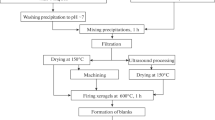Abstract
Xerogels in the ZrO2–Y2O3–CeO2 system are obtained by coprecipitation. The influence of the synthesis method on the acid-base xerogel surface properties are studied. The sinuous dependence of the Lewis and Brønsted site content on the particle surface on the conditioning time of precipitates in the mother liquor and the presence of subsequent low-temperature processing is established. The relationship is established between the resulting ceramics properties, precipitate processing conditions, and the functional xerogel structure.

Similar content being viewed by others
REFERENCES
Gevorkyan, E.S., Mel’nik, O.M., Chishkala, V.A., and Sirota, V.V., Phase and structural process in nanocrystalline powders based on zirconia dioxide, Ogneupory Tekh. Keram., 2012, nos. 7–8, pp. 26–31.
Popov, V.V. and Petrunin, V.F., Investigating the formation processes and stability of metastable phase in nanocrystalline ZrO2, Ogneupory Tekh. Keram., 2007, no. 8, pp. 8–13.
Dudnik, E.V., Shevchenko, A.V., Ruban, A.K., Red’ko, V.P., and Lopato, L.M., Effect of Al2O3 on the properties of nanocrystalline ZrO2 + 3 mol % Y2O3 powder, Inorg. Mater., 2010, vol. 46, no. 2, pp. 172–176.
Antsiferov, V.N., Porozova, S.E., Kul’met’eva, V.B., and Torsunov, M.F., Phase composition of nanodisperse zirconia powders stabilized by yttria and ceria, Ogneupory Tekh. Keram., 2012, no. 4-5, pp. 17–21.
Shevchenko, A.V., Lashneva, V.V., Dudnik, E.V., Ruban, A.K., and Podzorova, L.I., Nanosist., Nanomater., Nanotekhnol., 2011, vol. 9, no. 4, pp. 881–893.
Lukin, E.S., Modern high-density oxide ceramics with the controlled microstructure. Pt. 1. Oxide powder aggregation effect on the ceramics sintering and microstructure, Ogneupory Tekh. Keram., 1996, no. 1, pp. 5–12.
Lin, J.-D. and Duh, J.-G., Correlation of mechanical properties and composition in tetragonal CeO2–Y2O3–ZrO2 ceramic system, Mater. Chem. Phys., 2002, no. 78, pp. 246–252.
Kravchik, K.V., Gomza, Yu.P., Pashkova, O.V., Belous, A.G., and Nesin, S.D., Effect of zirconium and yttrium hydroxide precipitation conditions on the fractal structure of the resulting xerogels and 0.97ZrO2 · 0.03Y2O3 powders, Inorg. Mater., 2007, vol. 43, no. 3, pp. 258–263.
Vasserman, I.M., Khimicheskoe osazhdenie iz rastvorov (Chemical Deposition from Solutions), Leningrad: Khimiya, 1980.
Kul’met’eva, V.B., Porozova, S.E., and Gnedina, E.S., Synthesis of nanocrystalline yttrium oxide stabilized zirconia for low temperature sintering, Izv. Vyssh. Uchebn. Zaved., Poroshk. Metall. Funkts. Pokryt., 2011, no. 2, pp. 3–9.
Ivanova, E.A. and Konakov, V.G., Problems of powde-precursor agglomeration of system ZrO2–HfO2–Y2O3, Vestn. SPbGU, Ser. 4, 2007, no. 2, pp. 106–110.
Koval’ko, N.Yu., Kalinina, M.V., Maslennikova, T.P., Morozova, L.V., Myakin, S.V., Khamova, T.V., Arsent’ev, M.Yu., and Shilova, O.A., Comparative study of powders based on the ZrO2–Y2O3–CeO2 system obtained by various liquid phase methods of synthesis, Glass Phys. Chem., 2018, vol. 44, no. 5, pp. 433–439.
Petrunin, V.F., Popov, V.V., Zhu, Hongzhi, and Timofeev, A.A., Synthesis of nanocrystalline high-temperature zirconia phases, Inorg. Mater., 2004, vol. 40, no. 3, pp. 251–258.
Antsiferov, V.N. and Makarova, E.N., Study of ultrasonic treatment and pre-wetting in ethanol on ZrO2–Y2O3–CeO2–Al2O3 nanopowders size distribution and agglomeration degree, Perspekt. Mater., 2015, no. 1, pp. 41–48.
Porozova, S.E., Vokhmyanin, D.S., and Kul’met’eva, V.B., Some features nanopowders compacting zirconia, Ogneupory Tekh. Keram., 2013, no. 9, pp. 10–14.
Panova, T.I., Arsent’ev, M.Yu., Morozova, L.V., and Drozdova, I.A., Synthesis and investigation of the structure of ceramic nanopowders in the ZrO2–CeO2–Al2O3 system, Glass Phys. Chem., 2010, vol. 36, no. 4, pp. 470–477.
Morozova, L.V., Panova, T.I., Drozdova, I.A., and Shilova, O.A., Features of the production of nanoceramics based on stabilized zirconia for various functional purposes, Perspekt. Mater., 2011, no. S13, pp. 561–568.
Gvetadze, R.Sh., D’yakonenko, E.E., and Lebedenko, I.Yu., The study of aging, fatigue and degradation for the purpose of improving the reliability of dental Zirconia ceramics. A review of articles in world’s journals, Stomatologiya, 2016, no. 6, pp. 51–60.
Koval'ko, N.Yu., Kalinina, M.V., Malkova, A.N., Lermontov, S.A., Morozova, L.V., Polyakova, I.G., and Shilova, O.A., Synthesis and comparative studies of xerogels, aerogels, and powders based on the ZrO2–Y2O3–CeO2 system, Glass Phys. Chem., 2017, vol. 43, no. 4, pp. 368–375.
Morozova, L.V., Kalinina, M.V., Koval’ko, N.Yu., Arsent’ev, M.Yu., and Shilova, O.A., Preparation of zirconia-based nanoceramics with a high degree of tetragonality, Glass Phys. Chem., 2014, vol. 40, no. 3, pp. 352–355.
Sychev, M.M., Minakova, T.S., Slizhov, Yu.G., and Shilova, O.A., Kislotno-osnovnye kharakteristiki poverkhnosti tverdykh tel i upravlenie svoistvami materialov i kompozitov (Acid-Base Characteristics of the Surface of Solids and Control of the Properties of Materials and Composites), St. Petersburg: Khimizdat, 2016.
Nechiporenko, A.P., Donorno-aktseptornye svoistva poverkhnosti tverdofaznykh sistem. Indikatornyi metod (Donor-Acceptor Surface Properties of Solid-Phase Systems. Indicator Method), St. Petersburg: Lan’, 2017.
GOST (State Standard) 21216-2014: Clay Raw Materials. Test Methods, Moscow: Standartinform, 2015.
GOST (State Standard) 473.4-81: Chemically Resistant and Heat Resistant Ceramic Wears. The Method for Determination of Apparent Density and Apparent Sponginess, Moscow: Standartinform, 1981.
GOST (State Standard) 9450-76: Measurements of Microhardness by Diamond Instruments Indentation, Moscow: Standartinform, 1976.
Irodov, I.E., Volnovye protsessy (Wave Processes), Moscow: Lab. Bazov. Znanii, 2003.
Generalov, M.B., Kriokhimicheskaya nanotekhnologiya: Ucheb. posobie dlya vuzov (Cryochemical Nanotechnology: A Textbook), Moscow: Akademkniga, 2006.
Funding
This work was partially supported by the Russian Science Foundation (project no. 19-13-00442).
Author information
Authors and Affiliations
Corresponding author
Additional information
Translated by A. Kolemesin
Rights and permissions
About this article
Cite this article
Fedorenko, N.Y., Myakin, S.V., Frank, V.M. et al. Influence of Xerogel Synthesis Conditions in the ZrO2–Y2O3–CeO2 System on the Properties of Powders and Ceramics Based on Them. Glass Phys Chem 46, 176–180 (2020). https://doi.org/10.1134/S1087659620020030
Received:
Revised:
Accepted:
Published:
Issue Date:
DOI: https://doi.org/10.1134/S1087659620020030




